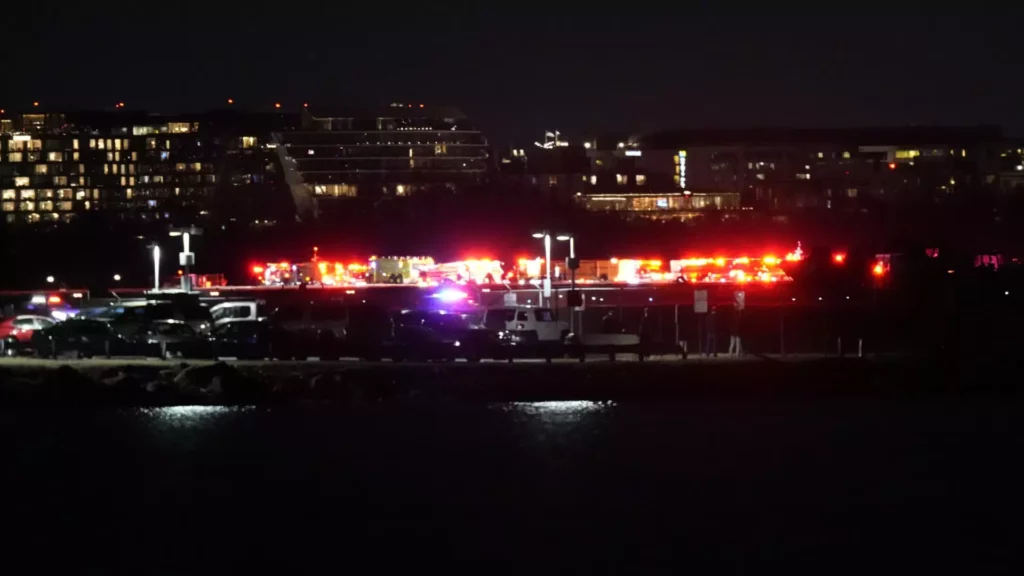On a seemingly routine evening for aviation in the United States, the skies over Washington D.C. turned deadly. An American Airlines regional jet, American Eagle Flight 5342, with 64 souls aboard, collided with a Sikorsky Black Hawk helicopter just moments before landing at Ronald Reagan Washington National Airport. As the jet approached for a landing, it was at an altitude of 300 feet when it intersected the flight path of a military helicopter, ultimately resulting in a catastrophic event. This horrific incident has shaken public confidence in aviation safety protocols, particularly after a lengthy period free from commercial aviation disasters.
The immediate aftermath of such tragedies demands not only swift rescue operations but also effective coordination among numerous agencies. Rescue teams faced grim conditions as they navigated the cold Potomac waters, battling high winds while combing through debris. The involvement of the Army’s training helicopter from Fort Belvoir raises serious questions about operational protocols and the potential for communication lapses between civilian and military air traffic control. Such a lamentable oversight emphasizes the need for refined safety measures in both aviation realms—commercial and military—to safeguard lives.
With every air disaster, the discourse surrounding accountability resurfaces. After an incident that is being described as the worst civil aviation disaster in over a decade, the conversation shifts to the agencies responsible for ensuring air safety. The absence of a permanent head for the Federal Aviation Administration (FAA) following the change in administration draws attention to potential leadership issues within the organization. It is concerning when oversight bodies lack the necessary guidance during challenging times. The recent abrupt turnover in leadership in critical departments should call for an urgent reevaluation of the processes that underpin our aviation safety regulations.
In the wake of this tragedy, it is imperative that the authorities maintain transparency about the ongoing investigation. Early reports indicate that bodies have already begun recovering from the river, an unsettling detail that must be managed with sensitivity for the victims’ families. Furthermore, the failure to address casualties during initial press conferences is a misstep that sows deeper distrust among the public. It’s essential for officials to communicate with openness and tact, as silence or evasion will only fuel speculation and fear in an already anxious populace.
Historically, the United States has prided itself on its robust air safety record. The last major crash involving a commercial airline happened back in February 2009, leading to sweeping reform in pilot regulations. Yet, as the age-old saying goes, “history doesn’t repeat itself, but it often rhymes.” The repugnant familiarity of aviation disasters reminds us that complacency can lead to disastrous consequences. Human beings penchant for convenience can inadvertently create vulnerabilities in a system that relies heavily on precision and timeliness.
The FAA and National Transportation Safety Board’s parallel investigations will be pivotal in determining the cause of this tragic accident. It’s essential for the investigations to scrutinize not just the immediate causative factors but also the broader systemic issues at play. Ignoring potential infrastructural weaknesses or operational deficiencies could mean we repeat similar mistakes in the future. The stakes are exceedingly high; ensuring the safety of hundreds of millions of passengers annually necessitates unwavering diligence and a fundamental reassessment of existing aviation protocols.
The incident of Flight 5342 serves as a grave reminder of the vulnerabilities within our aviation system. It lays bare the necessity for deeper engagement from regulatory bodies—especially when we face such grievous tragedies. As we grapple with the implications of this calamity, one cannot help but reflect on whether our aviation safeguards have kept pace with the complexities of modern air travel, and whether lives could have been saved through more stringent measures.

